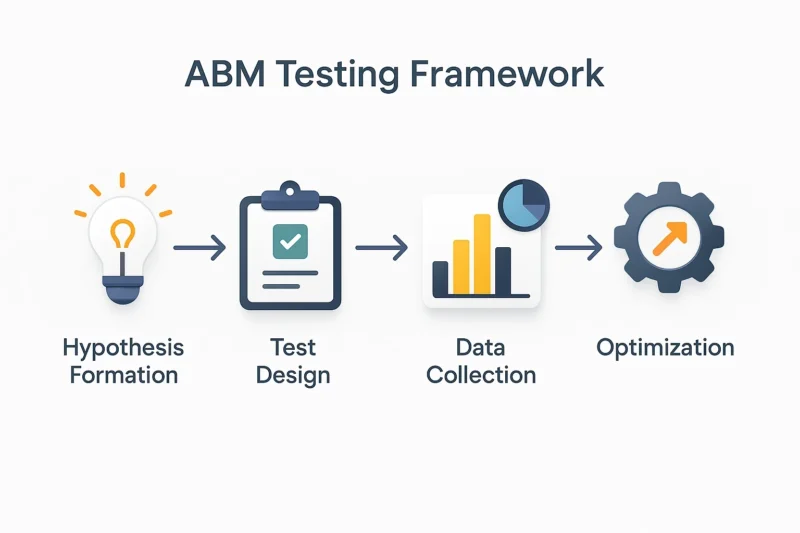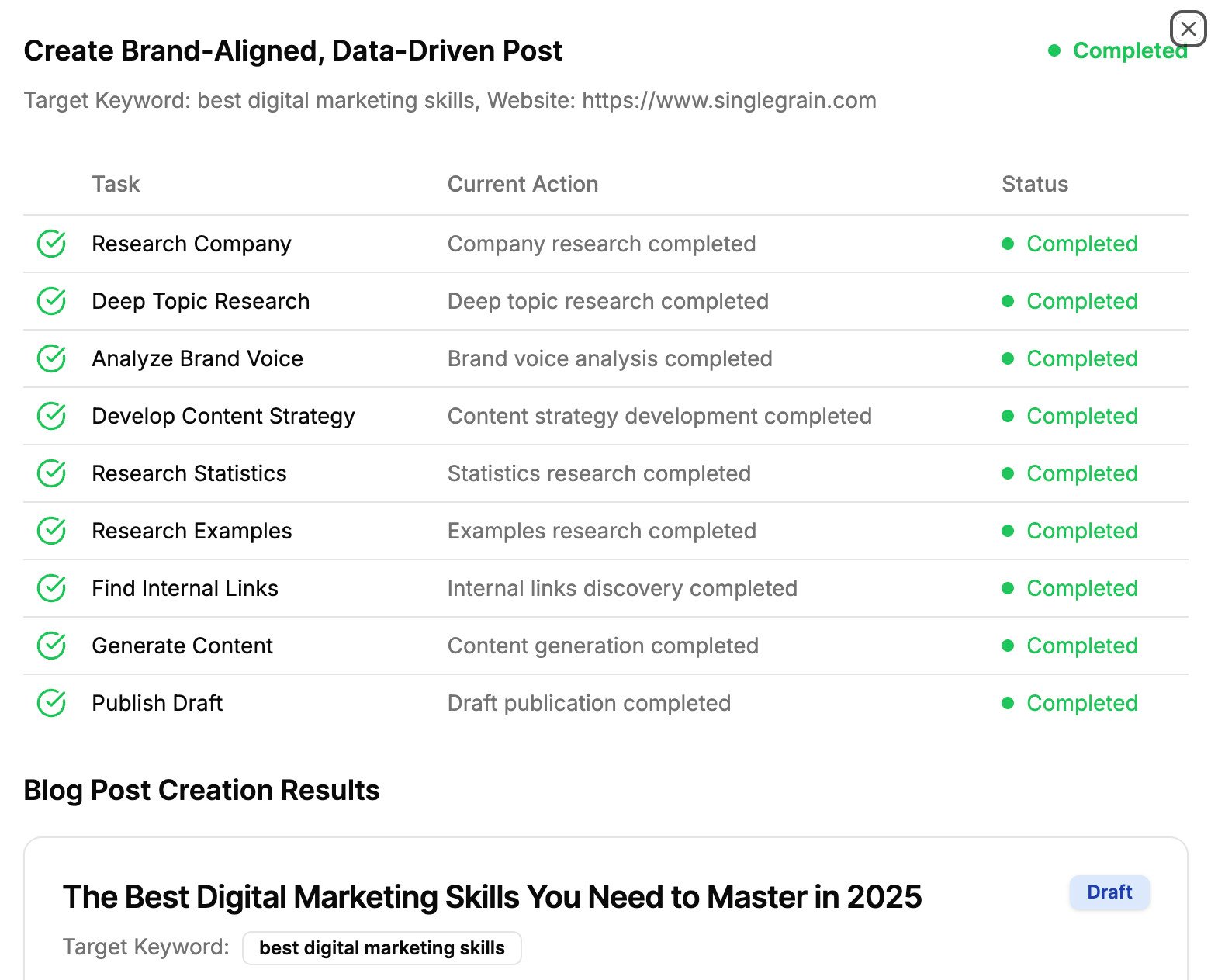How to A/B Test ABM Campaigns for Maximum ROI
When Gartner research shows that implementing account-based marketing lifts overall pipeline conversion rates by 14%, the question isn’t whether ABM works. It’s how to make it work even better. The answer lies in systematic ABM testing, a discipline that transforms educated guesses into data-driven wins.
Unlike traditional A/B testing that optimizes for broad audiences, ABM testing requires a fundamentally different approach. You’re not testing campaigns for thousands of anonymous visitors; you’re optimizing highly personalized touchpoints for a curated list of high-value accounts. This precision demands specialized frameworks, metrics, and methodologies that most marketing teams haven’t mastered yet.
Key Takeaways
- ABM testing requires fundamentally different metrics than traditional A/B testing – focus on account engagement velocity, pipeline influence, and deal acceleration rather than click-through rates, as you’re optimizing for 50-500 high-value accounts instead of thousands of anonymous visitors
- Extend your ABM testing duration to 6-12 weeks minimum to accommodate B2B sales cycles and allow meaningful account-level engagement patterns to emerge, compared to the typical 2-4 week traditional testing periods
- Segment target accounts by meaningful business variables such as industry, growth stage, or competitive displacement opportunity, maintaining groups of 20-50 accounts to balance statistical validity with personalization depth
- Test across four critical ABM dimensions – messaging optimization for specific account challenges, creative format experimentation, offer structure analysis, and multi-channel sequence optimization to maximize campaign testing effectiveness
- Leverage automation tools to scale ABM optimization while maintaining personalization, as modern ABM platforms can automatically rotate creative variations and track account-level engagement patterns across extended sales cycles
TABLE OF CONTENTS:
What Makes ABM Testing Different from Traditional A/B Testing
ABM testing operates in a completely different paradigm than standard conversion optimization. While traditional A/B testing seeks statistical significance from large sample sizes, ABM testing focuses on meaningful insights from smaller, highly targeted account sets.
The fundamental difference lies in the unit of measurement. Traditional testing measures individual user behavior across broad segments. ABM testing measures account-level engagement patterns, where a single decision-maker’s response can influence a six or seven-figure deal. This shift from volume to value changes everything about how you design, execute, and interpret tests.
| Aspect | Traditional A/B Testing | ABM Testing |
|---|---|---|
| Sample Size | Thousands of users | 50-500 target accounts |
| Success Metrics | Click-through rates, form fills | Pipeline influence, deal velocity |
| Personalization Level | Segment-based | Account-specific |
| Statistical Confidence | 95% significance threshold | Directional insights with qualitative validation |
| Test Duration | 2-4 weeks | 6-12 weeks (longer sales cycles) |
Consider how Harri approached this challenge. Rather than testing broad messaging across their entire database, they ran precision ABM tests on small, highly-targeted account lists in the hospitality sector. Using AI-powered email variations and predictive analytics, they generated $12 million in new pipeline and $3 million closed-won in a single quarter. Results that would be impossible to achieve with traditional testing approaches.
Why ABM Testing Delivers Outsized Returns
The business case for ABM testing becomes clear when you consider the stakes involved. In traditional marketing, a failed campaign might waste budget on unqualified leads. In ABM, a missed opportunity with a target account can mean losing a million-dollar deal to a competitor.

This high-stakes environment makes systematic testing essential, not optional. RollWorks data reveals that ad-influenced ABM accounts advance through the sales pipeline 234% faster than non-ad-influenced accounts—but only when those ads are optimized through iterative testing.
“Small-batch A/B testing of messaging within tightly defined account lists can unlock outsized pipeline impact in ABM programs. The key is treating each account cluster as its own experiment, not trying to find one-size-fits-all solutions.”
The velocity advantage becomes even more pronounced when you integrate multiple channels. Companies that systematically test ABM advertising alignment achieve 60% higher win rates than those operating without structured optimization frameworks.
Essential Types of ABM Campaign Tests
Effective ABM testing spans four critical dimensions, each requiring specialized approaches tailored to account-based dynamics.
Messaging Optimization Tests
Message testing in ABM goes beyond subject line variations. You’re testing value propositions that resonate with specific account challenges, industry dynamics, and competitive landscapes. Successful tests examine pain point emphasis, outcome framing, and urgency triggers specific to target account priorities.
Payscale exemplifies this approach through their systematic testing of personas and ad creative. By executing iterative A/B tests on messaging tailored to emerging startup accounts, they reduced time-to-close by 45% while increasing target-account site traffic by 500%.
Creative Format Experimentation
Visual elements carry disproportionate weight in account-based campaigns because they must instantly communicate relevance to busy executives. Test static versus video content, personalized imagery featuring account logos or industry-specific visuals, and interactive elements like calculators or assessments.
Offer Structure Analysis
High-value accounts require offers that match their sophistication and risk profiles. Test educational content (whitepapers, research reports) against interactive experiences (demos, trials), and evaluate how offer complexity affects engagement patterns across different account tiers.
Channel Mix Optimization
ABM success often depends on orchestrated multi-channel sequences rather than single-touch campaigns. Test LinkedIn advertising versus direct email outreach, event invitations against content syndication, and sequence timing across channels to identify optimal touchpoint combinations.

Building Your ABM Testing Framework
Successful ABM testing requires structured methodologies that account for longer sales cycles, smaller sample sizes, and complex buying processes. The framework begins with hypothesis formation rooted in account intelligence and progresses through controlled experimentation to actionable optimization.
Hypothesis Development Process
Strong ABM hypotheses combine account research with behavioral insights. Rather than generic assumptions about industry preferences, develop testable theories about specific account challenges, competitive dynamics, and decision-making processes. Each hypothesis should predict both directional change and business impact.
Account Segmentation Strategy
Effective segmentation balances homogeneity with statistical validity. Group accounts by industry, company size, growth stage, or competitive displacement opportunity. Variables that meaningfully impact message resonance. Maintain segment sizes of 20-50 accounts to enable meaningful comparison while preserving personalization depth.
Controlled Experiment Design
ABM testing requires modified experimental design to accommodate account-level variables. Control for external factors like seasonality, competitive activity, and internal sales capacity. Design tests that isolate single variables while maintaining campaign coherence across the entire account experience.
Metrics That Drive ABM Optimization
Traditional conversion metrics often mislead in ABM contexts because they don’t capture account-level engagement depth or pipeline influence. Focus on metrics that directly correlate with revenue outcomes and buying signal strength.
Account engagement velocity matters more than absolute engagement rates. Track how quickly accounts move from awareness touchpoints to sales conversations, and measure engagement consistency across multiple stakeholders within target accounts. These leading indicators predict pipeline creation more accurately than click-through rates or form submissions.
Pipeline influence attribution requires sophisticated tracking that connects campaign touchpoints to revenue outcomes. Measure not just lead generation but deal acceleration, win rate improvement, and average contract value increases attributable to specific test variants.
Personify demonstrates this approach through their granular persona and stage-specific testing. By segmenting audiences and running multivariate ad tests tailored to each segment, they achieved a 39x increase in engaged website visitors from target accounts, directly expanding qualified pipeline.
Automation Tools for Scalable ABM Testing
Manual ABM testing doesn’t scale beyond the smallest account lists. Modern ABM testing requires integrated technology stacks that automate personalization, streamline data collection, and enable rapid iteration cycles.
Leading ABM platforms now incorporate native A/B testing capabilities that maintain personalization depth while enabling statistical comparison. These tools automatically rotate creative variations, track account-level engagement patterns, and surface optimization opportunities based on cumulative performance data.
Marketing automation integration ensures test consistency across email sequences, social campaigns, and website experiences. When account profiles update based on engagement behavior, automated systems can adjust messaging variants and offers to maintain relevance throughout extended sales cycles.
For organizations seeking comprehensive ABM campaign testing expertise, specialized ABM testing companies offer the technical infrastructure and analytical expertise required for sophisticated optimization programs. Get a Free ABM Audit.
Frequently Asked Questions About ABM Testing
How is ABM testing different from standard A/B testing?
ABM testing focuses on account-level insights rather than individual user behavior, uses smaller but more valuable sample sizes, and measures pipeline influence instead of just conversion rates. The methodology accounts for longer sales cycles and multiple stakeholders within each target account.
How long should ABM tests run?
ABM tests typically require 6-12 weeks to generate meaningful insights, significantly longer than traditional 2-4 week A/B tests. The extended duration accounts for B2B sales cycles and allows time for account-level patterns to emerge across multiple touchpoints.
Can ABM testing work with small target account lists?
Yes, ABM testing is specifically designed for smaller, high-value account sets. Lists as small as 50 accounts can generate actionable insights when properly segmented and when tests focus on directional improvements rather than statistical significance thresholds.
What metrics are most useful for ABM testing?
Focus on account engagement velocity, multi-stakeholder participation rates, pipeline influence attribution, and deal acceleration metrics. These leading indicators predict revenue outcomes more accurately than traditional marketing metrics like click-through rates.
How can automation tools make ABM testing easier?
Modern ABM platforms automate personalization at scale, track account-level engagement across channels, and provide real-time optimization recommendations. Automation enables consistent test execution while maintaining the personalization depth that makes ABM effective.
Your Next Steps Toward ABM Testing Mastery
ABM testing transforms marketing from educated guesswork into precision revenue generation. The organizations that master these methodologies in 2025 will establish sustainable competitive advantages in account acquisition and expansion.
Start by auditing your current ABM campaigns for testing opportunities. Identify your highest-value account segments, document existing performance baselines, and design your first controlled experiment around a single, measurable hypothesis. Remember that ABM testing is an iterative discipline. Each experiment builds knowledge that improves the next round of optimization.
The path from ABM testing novice to optimization expert requires both strategic frameworks and tactical execution. Comprehensive ABM strategies provide the foundation, while systematic testing delivers the competitive edge that separates market leaders from followers.
Your accounts are waiting. Your pipeline depends on it. Start testing today.
Ready to turn your ABM campaigns into revenue-generating machines instead of expensive experiments?
Frequently Asked Questions
-
How long should ABM tests run to generate meaningful results?
ABM tests typically require 6-12 weeks to generate actionable insights, significantly longer than traditional 2-4 week A/B tests. The extended duration accommodates B2B sales cycles and allows time for account-level engagement patterns to emerge across multiple touchpoints.
-
What sample size do I need for effective ABM testing?
ABM testing works with smaller, high-value account sets of 50-500 target accounts, compared to thousands in traditional testing. Segment groups should contain 20-50 accounts to balance statistical validity with personalization depth while focusing on directional insights rather than statistical significance.
-
Which metrics should I prioritize when measuring ABM test performance?
Focus on account engagement velocity, pipeline influence attribution, and deal acceleration rather than traditional metrics like click-through rates. These leading indicators better predict revenue outcomes and capture the multi-stakeholder engagement patterns crucial in B2B sales cycles.
-
What are the most important types of ABM tests to run?
Test across four critical dimensions: messaging optimization for specific account challenges, creative format experimentation, offer structure analysis, and multi-channel sequence optimization. Each dimension requires specialized approaches tailored to account-based dynamics and high-value decision-making processes.
-
How should I segment my target accounts for ABM testing?
Segment accounts by meaningful business variables such as industry, company size, growth stage, or competitive displacement opportunity. Maintain homogeneous groups that share similar challenges and decision-making processes to ensure test results are actionable and relevant.
-
Can ABM testing be automated while maintaining personalization?
Yes, modern ABM platforms can automatically rotate creative variations, track account-level engagement patterns, and provide real-time optimization recommendations. Automation tools enable consistent test execution across extended sales cycles while preserving the personalization depth that makes ABM effective.
-
How do I develop strong hypotheses for ABM testing?
Combine account research with behavioral insights to create testable theories about specific account challenges, competitive dynamics, and decision-making processes. Each hypothesis should predict both directional change and measurable business impact rather than relying on generic industry assumptions.





